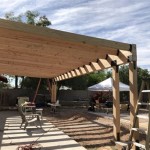```html
Building Patio Roof: A Comprehensive Guide
A patio roof offers a multitude of benefits, transforming an open-air space into a more functional and comfortable outdoor living area. Protection from the elements, shade from the sun, and an extension of your indoor living space are just some of the advantages. Constructing a patio roof is a significant undertaking, requiring careful planning, adherence to building codes, and a solid understanding of construction principles. This article aims to provide a comprehensive guide to the process, covering essential considerations and steps involved in building a durable and aesthetically pleasing patio roof.
Before embarking on the construction process, thorough planning is paramount. This includes determining the size and shape of the patio roof, selecting appropriate materials, and obtaining the necessary permits. The size of the roof should be proportional to the patio area and consider the desired level of shade and coverage. Material selection will impact the overall aesthetic, durability, and cost of the project. Finally, local building codes must be reviewed and permits acquired to ensure compliance and avoid potential legal issues later on.
Key Point 1: Planning and Design Considerations
The initial planning phase is crucial for ensuring a successful patio roof construction. This involves several key considerations, including design, structural integrity, material selection, and compliance with local building codes.
Design: The design of the patio roof should complement the existing architecture of the house and meet the homeowner's specific needs. Consider the desired level of shade, the direction of sunlight, and the prevailing wind patterns. Common design options include flat roofs, gabled roofs, and shed roofs. A flat roof is relatively simple to construct but may require careful attention to drainage. A gabled roof offers better water run-off but is more complex to build. A shed roof is a simple sloped roof that can effectively deflect rain and snow.
Structural Integrity: The patio roof must be structurally sound to withstand wind loads, snow loads (if applicable), and its own weight. This requires careful consideration of the span lengths, the size and spacing of the support beams, and the type of fasteners used. Consulting with a structural engineer is highly recommended, especially for larger or more complex designs. They can provide calculations and recommendations to ensure the roof meets all safety requirements.
Material Selection: The choice of materials will significantly impact the cost, appearance, and durability of the patio roof. Common materials include wood, aluminum, and composite materials. Wood is a popular choice for its aesthetic appeal and versatility, but it requires regular maintenance to prevent rot and insect damage. Aluminum is lightweight, durable, and resistant to corrosion, making it a good option for coastal areas. Composite materials offer the look of wood with the durability and low maintenance of synthetic materials. Roofing materials can include shingles, metal roofing, polycarbonate panels, or even shade cloth, depending on the desired level of protection and aesthetic.
Building Codes and Permits: Before starting any construction, it is essential to check with the local building department to determine the required permits and codes. These codes are in place to ensure the safety and structural integrity of the roof. Failure to comply with building codes can result in fines or even the requirement to dismantle the structure. The permitting process typically involves submitting detailed plans and specifications for review and obtaining inspections at various stages of construction.
Accurate and detailed plans are essential for obtaining permits and guiding the construction process. These plans should include the dimensions of the patio roof, the location of support posts, the type and size of materials to be used, and details of the foundation and connections. The plans should be drawn to scale and clearly labeled.
Key Point 2: Foundation and Support Structure
A solid foundation and robust support structure are critical for the stability and longevity of the patio roof. The foundation anchors the support posts, which in turn support the roof structure. The foundation must be designed to withstand the weight of the roof and resist uplift from wind forces.
Foundation Options: There are several foundation options available, including concrete footings, precast concrete piers, and screw piles. Concrete footings are the most common choice and involve digging holes, pouring concrete, and setting anchor bolts to which the support posts will be attached. Precast concrete piers offer a faster and easier installation process, but they may not be suitable for all soil conditions. Screw piles are a good option for unstable soils or areas with high water tables. Consulting with a local engineer or experienced contractor can help determine the best foundation option for a specific site.
Support Post Installation: Once the foundation is in place, the support posts can be installed. The posts should be made of treated lumber or another durable material that is resistant to rot and insect damage. The posts should be plumb and level and securely attached to the foundation using appropriate fasteners. The spacing of the posts will depend on the span lengths of the roof and the load-bearing capacity of the materials used.
Beam and Rafter Placement: Beams are horizontal structural members that span between the support posts and support the rafters. Rafters are sloped structural members that extend from the beam to the roof ridge or wall. The beams and rafters should be sized appropriately to support the weight of the roof and withstand wind and snow loads. They should be securely fastened to the support posts and each other using appropriate connectors.
The connection between the support posts and the roof structure is a critical point of structural integrity. Use appropriate metal connectors, such as post bases, post caps, and angle brackets, to ensure a strong and secure connection. Follow the manufacturer's instructions for installation and use the correct size and type of fasteners.
Key Point 3: Roofing and Finishing
The roofing material provides protection from the elements and contributes to the overall aesthetic of the patio roof. The choice of roofing material will depend on several factors, including the desired level of protection, the aesthetic preferences, and the budget.
Roofing Material Options: Common roofing materials include asphalt shingles, metal roofing, polycarbonate panels, and shade cloth. Asphalt shingles are a cost-effective and durable option that comes in a variety of colors and styles. Metal roofing is more expensive but offers excellent durability and longevity. Polycarbonate panels are lightweight and translucent, allowing natural light to filter through. Shade cloth provides shade and ventilation while still allowing some sunlight to penetrate.
Roofing Installation: The installation of the roofing material should be done according to the manufacturer's instructions. This typically involves installing underlayment, flashing, and the roofing material itself. Underlayment provides a waterproof barrier between the roof deck and the roofing material. Flashing is used to seal around chimneys, vents, and other penetrations in the roof to prevent water from entering. Proper installation is crucial to prevent leaks and ensure the longevity of the roof.
Finishing Touches: Once the roofing is installed, the finishing touches can be added to enhance the appearance of the patio roof. This may include installing trim, painting or staining the wood, and adding lighting or electrical outlets. Trim can be used to cover exposed edges and create a more finished look. Painting or staining the wood can protect it from the elements and enhance its aesthetic appeal. Adding lighting can extend the usability of the patio into the evening hours. Electrical outlets can be used to power outdoor appliances and accessories.
Proper drainage is essential to prevent water damage to the patio roof and surrounding structures. Ensure that the roof has adequate slope to allow water to run off. Install gutters and downspouts to collect and divert rainwater away from the foundation. Consider adding landscaping around the patio to help absorb rainwater and prevent erosion.
Building a patio roof is a complex project that requires careful planning, attention to detail, and adherence to building codes. Consulting with experienced professionals, such as structural engineers and contractors, can help ensure a successful and safe outcome. Thorough research, careful material selection, and proper installation techniques are essential for creating a durable and aesthetically pleasing patio roof that will provide years of enjoyment.
```
Patio Cover Plans Build Your Or Deck

Patio Cover Plans Build Your Or Deck

Patio Cover Plans Build Your Or Deck

Why A Patio Cover Is Essential

Photos How To Build A Patio Cover With Corrugated Metal Roof Open Lattice Building Diy

Building A Patio Cover Plans For An Almost Free Standing Roof

How To Build A Patio Cover Part 1 Wilker Do S

Building A Patio Cover Plans For An Almost Free Standing Roof

Building A Covered Patio With 30ft Span The Awesome Orange
Building A Covered Patio With 30ft Span The Awesome Orange
Related Posts








